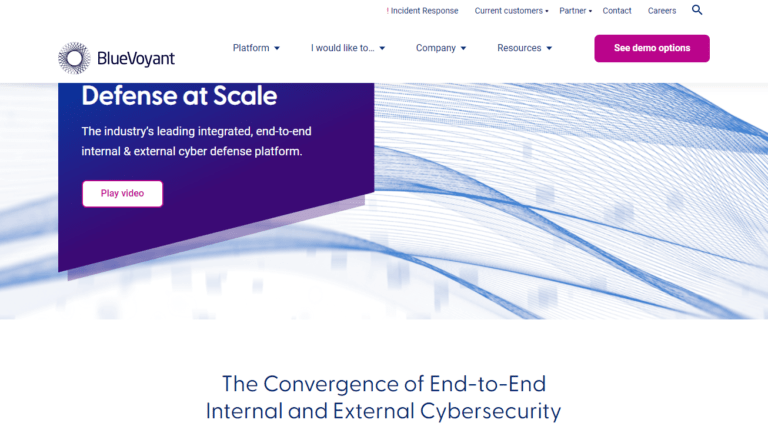
BlueVoyant
Founded Year
2017Stage
Series E | AliveTotal Raised
$665.5MLast Raised
$140M | 1 yr agoMosaic Score The Mosaic Score is an algorithm that measures the overall financial health and market potential of private companies.
+5 points in the past 30 days
About BlueVoyant
BlueVoyant is a company that provides security operations platform focused on cybersecurity. The company offers threat detection and response solutions for endpoints, networks, and cloud environments, as well as services for supply chain defense, digital risk protection, and cyber posture management. BlueVoyant serves sectors that require cybersecurity measures, such as the technology and finance industries. BlueVoyant was formerly known as BlueteamGlobal. It was founded in 2017 and is based in New York, New York.
Loading...
ESPs containing BlueVoyant
The ESP matrix leverages data and analyst insight to identify and rank leading companies in a given technology landscape.
The managed detection and response (MDR) market is an service-oriented approach to cybersecurity that focuses on proactively detecting and responding to advanced cyber threats and attacks. MDR providers offer continuous monitoring, analysis, and threat hunting capabilities, using a combination of technology, expertise, and threat intelligence. This service is designed to complement an organization…
BlueVoyant named as Outperformer among 15 other companies, including Cisco, CrowdStrike, and Tata Consultancy Services.
Loading...
Research containing BlueVoyant
Get data-driven expert analysis from the CB Insights Intelligence Unit.
CB Insights Intelligence Analysts have mentioned BlueVoyant in 1 CB Insights research brief, most recently on Feb 25, 2022.
Expert Collections containing BlueVoyant
Expert Collections are analyst-curated lists that highlight the companies you need to know in the most important technology spaces.
BlueVoyant is included in 2 Expert Collections, including Unicorns- Billion Dollar Startups.
Unicorns- Billion Dollar Startups
1,257 items
Cybersecurity
10,243 items
These companies protect organizations from digital threats.
BlueVoyant Patents
BlueVoyant has filed 4 patents.
The 3 most popular patent topics include:
- botnets
- computer network security
- computer security

Application Date | Grant Date | Title | Related Topics | Status |
|---|---|---|---|---|
6/3/2022 | 10/1/2024 | Computer network security, Botnets, Computer security, Spamming, Distributed computing projects | Grant |
Application Date | 6/3/2022 |
|---|---|
Grant Date | 10/1/2024 |
Title | |
Related Topics | Computer network security, Botnets, Computer security, Spamming, Distributed computing projects |
Status | Grant |
Latest BlueVoyant News
Jan 16, 2025
President Biden signs executive order to strengthen national cybersecurity in last days in office SHARE Outgoing U.S. President Joe Biden signed a cybersecurity-related executive order today that’s aimed at strengthening national cybersecurity and making it easier to pursue foreign adversaries and hacking groups that try to undermine U.S. systems. The “Executive Order on Strengthening and Promoting Innovation in the Nation’s Cybersecurity” covers a range of initiatives designed to address the evolving nature of cyberthreats and reinforce the country’s defenses. The order calls for the establishment of minimum cybersecurity standards for government technology contractors to ensure that contractors must demonstrate compliance with specific security benchmarks, reducing vulnerabilities in federal systems. The government aims to close gaps often exploited by threat actors in the supply chain by making sure that contractors are in compliance with minimum standards. To enhance national capabilities against foreign cyber adversaries, the order expands the scope of sanctions available under previous directives, including increased penalties targeting individuals and entities responsible for ransomware attacks on critical infrastructure, healthcare systems and other essential services. Quantum computing and artificial intelligence get a look-in in the executive order, with federal agencies being directed to adopt new cryptographic standards that can withstand the computational power of quantum attacks to ensure the long-term resilience of sensitive data and communication systems. On the AI front, the order mandates the development of AI-powered tools to automate the detection and response to vulnerabilities across government networks. The order also requires that all vendors to the U.S. government of Internet-of-Things devices be complaint and be U.S. Cyber Trust Mark labeled by Jan. 4, 2027. The Trust Mark, announced by the White House earlier this month , is a cybersecurity labeling program for internet-connected devices that aims to help consumers easily identify products that meet established cybersecurity standards. Finally, the order also allocates resources for workforce development in the cybersecurity sector, including funding for training programs and partnerships with educational institutions to create a pipeline of skilled professionals. The initiative aims to address the growing shortage of cybersecurity talent while promoting innovation in both the public and private sectors. Exactly how many of these policies introduced in the executive order will live past the inauguration of President-elect Trump on Monday are unclear, although there doesn’t appear to be any obvious partisan politics in the orders; on the surface, they seem reasonable and that’s a view shared by cybersecurity experts. “President Biden’s final cybersecurity executive order takes a bold step in addressing the evolving threats our nation faces, particularly from adversarial states like China, Russia and North Korea,” Andrew Borene, executive director of Global Security for cyber threat intelligence company Flashpoint and a former Office of the Director of National Intelligence senior official, told SiliconANGLE via email. “With its focus on secure software standards, emerging technologies, and critical infrastructure, the order demonstrates a clear understanding of the challenges at hand and the need for decisive action.” Recognizing the issues with the timing, Lorri Janssen-Anessi, director of External Cyber Assessments at supply chain defense firm BlueVoyant LLC. , noted that the “timing of the new order, coming at the tail end of an administration, raises legitimate concerns regarding the possibility of its implementation.” “That being said, it’s important to recognize that cybersecurity is largely viewed as a bipartisan issue,” Janssen-Anessi added. “Protecting national infrastructure and data from cyber threats is a shared priority across political divides. Given the critical nature of the threats and the fact that cyber incidents do not respect political boundaries, it is likely that the incoming administration will recognize the value in continuing to support and implement many of the executive order’s objectives.” One interesting takeaway is that despite the last-minute on-the-way-out timing, the executive order was apparently known to be coming. “This final executive order has been somewhat of an open secret in Washington, with drafts being circulated to a limited audience for a few weeks now,” Casey Ellis, founder of crowdsourced cybersecurity platform provider Bugcrowd Inc. , told SiliconANGLE. “The Whitehouse and especially departments like the Office of the National Cyber Director, have built up a lot of technical expertise on the topics covered by this EO over a particularly transformational time in technology and many of those involved are political appointees or staffers who’s tours are coming to a close.” Ellis is not confident that the executive order will remain in place, though, adding that “despite the strong chance that the order will be promptly reversed with the administration change, this EO is a clear effort to ensure that the core cybersecurity, safety and International Relations equities conclusions developed over the past four years are a part of the U.S. policy zeitgeist.” Image: SiliconANGLE/Ideogram A message from John Furrier, co-founder of SiliconANGLE: Your vote of support is important to us and it helps us keep the content FREE. One click below supports our mission to provide free, deep, and relevant content.
BlueVoyant Frequently Asked Questions (FAQ)
When was BlueVoyant founded?
BlueVoyant was founded in 2017.
Where is BlueVoyant's headquarters?
BlueVoyant's headquarters is located at 335 Madison Avenue, New York.
What is BlueVoyant's latest funding round?
BlueVoyant's latest funding round is Series E.
How much did BlueVoyant raise?
BlueVoyant raised a total of $665.5M.
Who are the investors of BlueVoyant?
Investors of BlueVoyant include Istari, Liberty Strategic Capital, Microsoft Security Excellence Awards, 8VC, Eden Global Partners and 6 more.
Who are BlueVoyant's competitors?
Competitors of BlueVoyant include BforeAI, Outpost Security, Difenda, Cyberint, SOCRadar and 7 more.
Loading...
Compare BlueVoyant to Competitors

Deepwatch provides managed security services. It focuses on cyber resilience within the cybersecurity industry. The company offers advanced threat detection and response capabilities, 24/7 monitoring, and optimization of security operations to enhance cyber resilience and reduce risk. Deepwatch leverages AI-powered technology and a team of expert security practitioners to improve clients' security posture and minimize alert volume and false positives. It was founded in 2019 and is based in Tampa, Florida.

ReliaQuest is a cybersecurity technology company that enhances security operations within the enterprise sector. Its main offering, the GreyMatter platform, provides security teams with tools for threat detection, investigation, and response, along with automation to improve efficiency and reduce alert noise and false positives. ReliaQuest serves sectors that require cybersecurity measures, including multi-cloud environments, mergers and acquisitions, and operational technology. It was founded in 2007 and is based in Tampa, Florida.

Cyrebro provides managed detection and response services in the cybersecurity field. The services include monitoring, threat detection, incident response, and threat intelligence. Cyrebro serves micro and SMBs, enterprises, and managed security service providers. Cyrebro was formerly known as CyberHat. It was founded in 2012 and is based in Tel Aviv, Israel.
ASecureLife focuses on providing security solutions and smart home technology. It offers a range of services, including home security systems, smart home devices, personal safety equipment, online security services, and financial security services. It primarily caters to individuals seeking to enhance the security of their homes and personal information. It was founded in 2008 and is based in Salt Lake City, Utah.

EclecticIQ provides threat intelligence technology and services within the cybersecurity domain. The company offers a platform that manages intelligence and facilitates cooperation across security teams to address cyber threats. It serves sectors that require strong cybersecurity measures, including government agencies and large enterprises. EclecticIQ was formerly known as Intelworks. It was founded in 2014 and is based in Amsterdam, Netherlands.

GoSecure specializes in managed Extended Detection and Response (MXDR) solutions and professional security services. The company provides services including incident response, security information and event monitoring, endpoint detection and response, and threat intelligence to protect against cyber threats. GoSecure serves sectors that require cybersecurity measures, such as the financial services, healthcare, and technology industries. It was founded in 2002 and is based in San Diego, California.
Loading...
